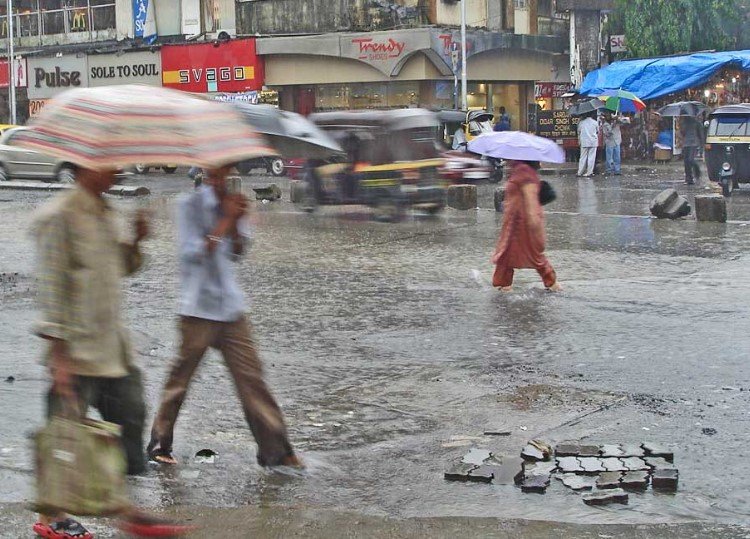Reservoirs Near Capacity, But Traffic Chaos and High Humidity Add to Monsoon Woes
Heavy rain swept across Mumbai early Monday morning, turning commutes chaotic and roads into waterlogged streams. The India Meteorological Department (IMD) has predicted further downpours and thunderstorms over the next 48 hours, adding to the challenges already facing the city as it grapples with persistent monsoon conditions.
Visuals from Chhatrapati Shivaji Maharaj Terminus (CSMT) showed commuters navigating knee-deep water while local trains operated with delays. While temperatures have dropped slightly, humidity remains oppressive, and the IMD’s forecast shows little respite in the immediate future.
Umbrellas Mandatory: Mumbai’s Weekly Rain Forecast
According to meteorologists, cloudy skies, strong winds, and intermittent showers will dominate the week. Though no red alerts have been issued, localized flooding has been reported across Dadar, Sion, Kurla, Andheri, and parts of Navi Mumbai.
Mumbai Weather at a Glance
| Day | Rainfall Intensity | Temperature (°C) | Humidity (%) | Advisory |
|---|---|---|---|---|
| Monday | Moderate to Heavy | 27–30 | 88–92 | Waterlogging, traffic delays |
| Tuesday | Moderate | 26–29 | 85–90 | Slippery roads, poor visibility |
| Wednesday | Light to Moderate | 25–28 | 86–91 | Intermittent rainfall expected |
| Thursday | Light | 25–27 | 80–85 | Slightly drier afternoon |
City Soaked, But Reservoirs Fill Up
Despite the disruption, the monsoon brings a silver lining: Mumbai’s water stock is close to its seasonal target. According to the Brihanmumbai Municipal Corporation (BMC), reservoir levels have reached 81.86% of total capacity — translating to 11.84 lakh million litres.

This is critical for a city that depends almost entirely on stored rainwater for drinking and municipal supply through the year. Mumbai’s seven key reservoirs — including Modak Sagar, Tansa, Bhatsa, and Vaitarna — are filling steadily.
Monsoon Mood Across India
Mumbai’s rains are part of a wider monsoon trend across India. States including Uttar Pradesh, Karnataka, Maharashtra, and Tamil Nadu have reported “normal” rainfall, defined by the IMD as being within ±19% of the long-period average.
In a country where 42% of the population relies on agriculture, and where monsoon rain replenishes the bulk of the drinking water supply and hydroelectric reserves, every drop matters.
Bullet Points: What Mumbaikars Need to Know Today
-
Western suburbs, including Borivali and Kandivali, likely to receive heavy rain during morning hours
-
Local trains are running with delays of 10–15 minutes; avoid non-essential travel during peak hours
-
IMD has advised caution in low-lying areas due to flash-flood potential
-
Carry umbrellas, raincoats, and ensure phones are charged in case of power Despite the discomfort, this is standard monsoon fare for Mumbai, a city that has learned to work — and even live — around the rain. For now, forecasts show no cyclone activity in the Arabian Sea, and rainfall levels are expected to remain manageable — if still inconvenient.
